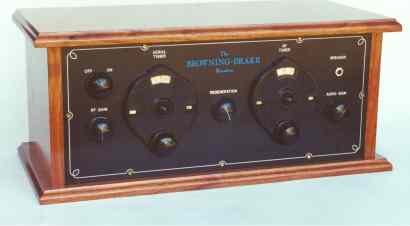Jim Lowe's prize winning B.D.
Early last year the Historical Radio Society Of Australia held a major competition for radio constructors.
The project consisted of building replica Browning Drakes. Much information was culled by members from old publications, from BD articles etc.
to be able to construct them to be as authentic as possible. There were 2 categories, actual submissions and postal. Judging was held at the end of the
year and the results were published in the January 2001 "Radio Waves" the quarterly publication of the HRSA. Also published in this issue was an article
by Jim where he comprehensively describes his BDs construction. The following is a very much condensed version.
Web Author.
 |
"I was quite thrilled to be informed that I had won the postal section of the Browning Drake competition.
For the information of others I shall set out how I constructed the receiver."
Coils: The heart of the receiver is the two tuning
coils. As it is rather difficult to obtain the double cotton covered wire
originally used I substituted modern enamelled wire. The problem here is
the difference in the diameter of the two wires. By cutting a 36 TPI
thread on the former to take the winding I was able to achieve the correct
spacing to closely adhere to the original.
|
 | For the regenaformer primary winding
I turned a ring from 1/4" perspex with a 0.5mm groove in the outer edge to take the winding this was just pressed into the main former. The tickler coil
was made a smaller diameter in similar manner but I glued two pieces together to take the 1/4" shaft. The nuts and bearings of two old wirewound pots
were fitted to each side of the coil former. The flexible leads were made from desoldering wick. |
The unique thing about the B.D. is the regenaformer and the above is a description of my approach to fabricating the one for my set, the rest of the
set is very typical of 4 valve neutrodynes. Fortunately I had in my "junk box" matching slow-motion friction dials, tuning capacitors, audio transformers,
valves etc.
Cabinet: This was my piece de resistance. I made the cabinet from solid red cedar (Toomis Australis). I have some red cedar planks, which once belonged
to my father who passed on 30 years ago. From these I made the cabinet. After looking at many photos of cabinets of the 20s I concluded they were mostly
of fairly plain style. With this in mind I settled for a classically simple design. After finishing the cabinet and spraying with 3 coats of nitrocellulose
lacquer I was very pleased with the results and there have been "oohs" and "aahs" from many who have viewed it.
Return to home

